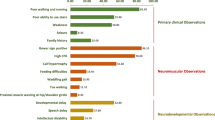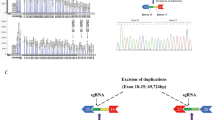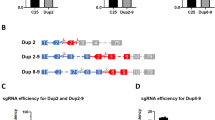Abstract
Mutations in the dystrophin gene result in the most common inherited muscle disease, Duchenne muscular dystrophy (DMD). Duplications spanning one or more exons have been found to be the second most common disease-causing mutation in the dystrophin gene. Although the duplicated exons are commonly thought to be arranged in tandem, rare noncontiguous exon duplications have been disclosed without clarifying their location or orientation. Here we present the first report that details the exact locations and orientations of noncontiguous duplications in the dystrophin gene. Multiplex ligation-dependent probe amplification analysis of the dystrophin gene of a Japanese boy with DMD revealed that his genomic DNA contained duplications of exons from two separate fragments of the gene: one from exon 45 to exon 48 and the other from exon 55 to exon 63. To clarify the locations and orientations of the duplicated exons, reverse transcription-nested PCR analysis of dystrophin mRNA was conducted. Interestingly, the extra copies of exons 45–48 and exons 55–63 were found to be properly oriented between exons 48 and 49 and exons 63 and 64, respectively. These results indicated that two tandem duplication events occurred in the dystrophin gene of this patient and should contribute to the understanding of the duplication mechanisms that contribute to the development of DMD.
Similar content being viewed by others
Log in or create a free account to read this content
Gain free access to this article, as well as selected content from this journal and more on nature.com
or
References
Beggs AH, Koenig M, Boyce FM, Kunkel LM (1990) Detection of 98% of DMD/BMD gene deletions by polymerase chain reaction. Hum Genet 86:45–48
Chamberlain JS, Gibbs RA, Ranier JE, Nguyen PN, Caskey CT (1988) Deletion screening of the Duchenne muscular dystrophy locus via multiplex DNA amplification. Nucleic Acids Res 16:11141–11156
Clemens P, Fenwick R, Chamberlain J, Gibbs R, de Andrade M, Chakraborty R, Caskey C (1991) Carrier detection and prenatal diagnosis in Duchenne and Becker muscular dystrophy families, using dinucleotide repeat polymorphisms. Am J Med Genet 49:951–960
Helleday T (2003) Pathways for mitotic homologous recombination in mammalian cells. Mutat Res 532:103–115
Hu XY, Ray PN, Murphy EG, Thompson MW, Worton RG (1990) Duplicational mutation at the Duchenne muscular dystrophy locus: its frequency, distribution, origin, and phenotypegenotype correlation. Am J Hum Genet 46:682–695
Hu XY, Ray PN, Worton RG (1991) Mechanisms of tandem duplication in the Duchenne muscular dystrophy gene include both homologous and nonhomologous intrachromosomal recombination. Embo J 10:2471–2477
Janssen B, Hartmann C, Scholz V, Jauch A, Zschocke J (2005) MLPA analysis for the detection of deletions, duplications and complex rearrangements in the dystrophin gene: potential and pitfalls. Neurogenetics 6:29–35
Lalic T, Vossen R, Coffa J, Schouten J, Guc-Scekic M, Radivojevic D, Djurisic M, Breuning M, White SdDJ (2005) Deletion and duplication screening in the DMD gene using MLPA. Eur J Hum Genet 13:1231–1234
Matsuo M, Masumura T, Nishio H, Nakajima T, Kitoh Y, Takumi T, Koga J, Nakamura H (1991) Exon skipping during splicing of dystrophin mRNA precursor due to an intraexon deletion in the dystrophin gene of Duchenne muscular dystrophy Kobe. J Clin Invest 87:2127–2131
White S, Kalf M, Liu Q, Villerius M, Engelsma D, Kriek M, Vollebregt E, Bakker B, van Ommen GJ, Breuning MH, den Dunnen JT (2002) Comprehensive detection of genomic duplications and deletions in the DMD gene, by use of multiplex amplifiable probe hybridization. Am J Hum Genet 71:365–374
White SJ, Aartsma-Rus A, Flanigan KM, Weiss RB, Kneppers AL, Lalic T, Janson AA, Ginjaar HB, Breuning MH, den Dunnen JT (2006) Duplications in the DMD gene. Hum Mutat 27:938–945
Woodward KJ, Cundall M, Sperle K, Sistermens EA, Ross M, Howell G, Gribble SM, Burford DC, Carter NP, Hobson DL, Garbem JY, Kamholz J, Heng H, Hodes ME, Malcolm S, Hobson GM (2005) Heterogeneous duplications in patients with Pelizaeus–Merzbacher disease suggest a mechanism of coupled homologous and nonhomologous recombination. Am J Hum Genet 77:966–987
Zeng F, Ren ZR, Huang SZ, Kalf M, Mommersteeg M, Smit M, White S, Jin CL, Xu M, Zhou DW, Yan JB, Chen MJ, van Beuningen R, Huang SZ, den Dunnen J, Zeng YT, Wu Y (2007) Array-MLPA: comprehensive detection of deletions and duplications and its application to DMD patients. Hum Mutat 13 Sep (Epub ahead of print)
Acknowledgments
We would like to thank Ms. Inagawa for her secretarial help. This work was supported by a grant-in-aid for scientific research from the Japan Society for the Promotion of Science; Health and Labor Sciences Research Grants for Research on Psychiatric and Neurological Diseases and Mental Health; a research grant for nervous and mental disorders from the Ministry of Health, Labor, and Welfare; and the Mitsubishi Foundation.
Author information
Authors and Affiliations
Corresponding author
Rights and permissions
About this article
Cite this article
Zhang, Z., Takeshima, Y., Awano, H. et al. Tandem duplications of two separate fragments of the dystrophin gene in a patient with Duchenne muscular dystrophy. J Hum Genet 53, 215–219 (2008). https://doi.org/10.1007/s10038-007-0235-1
Received:
Accepted:
Published:
Issue date:
DOI: https://doi.org/10.1007/s10038-007-0235-1
Keywords
This article is cited by
-
Präimplantationsdiagnostik – methodische Aspekte
medizinische genetik (2016)
-
A novel noncontiguous duplication in the DMD gene escapes the ‘reading-frame rule’
Journal of Genetics (2014)
-
MLPA-based genotype–phenotype analysis in 1053 Chinese patients with DMD/BMD
BMC Medical Genetics (2013)
-
Mutation spectrum of the dystrophin gene in 442 Duchenne/Becker muscular dystrophy cases from one Japanese referral center
Journal of Human Genetics (2010)
-
Insertion of the IL1RAPL1 gene into the duplication junction of the dystrophin gene
Journal of Human Genetics (2009)



